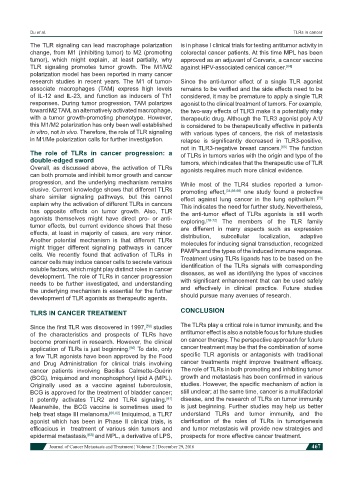Page 477 - Read Online
P. 477
Du et al. TLRs in cancer
The TLR signaling can lead macrophage polarization is in phase I clinical trials for testing antitumor activity in
change, from M1 (inhibiting tumor) to M2 (promoting colorectal cancer patients. At this time MPL has been
tumor), which might explain, at least partially, why approved as an adjuvant of Cervarix, a cancer vaccine
TLR signaling promotes tumor growth. The M1/M2 against HPV-associated cervical cancer. [64]
polarization model has been reported in many cancer
research studies in recent years. The M1 of tumor- Since the anti-tumor effect of a single TLR agonist
associate macrophages (TAM) express high levels remains to be verified and the side effects need to be
of IL-12 and IL-23, and function as inducers of Th1 considered, it may be premature to apply a single TLR
responses. During tumor progression, TAM polarizes agonist to the clinical treatment of tumors. For example,
toward M2 TAM, an alternatively activated macrophage, the two-way effects of TLR3 make it a potentially risky
with a tumor growth-promoting phenotype. However, therapeutic drug. Although the TLR3 agonist poly A:U
this M1/M2 polarization has only been well established is considered to be therapeutically effective in patients
in vitro, not in vivo. Therefore, the role of TLR signaling with various types of cancers, the risk of metastasis
in M1/Me polarization calls for further investigation. relapse is significantly decreased in TLR3-positive,
not in TLR3-negative breast cancers. The function
[65]
The role of TLRs in cancer progression: a of TLRs in tumors varies with the origin and type of the
double-edged sword tumors, which indicates that the therapeutic use of TLR
Overall, as discussed above, the activation of TLRs agonists requires much more clinical evidence.
can both promote and inhibit tumor growth and cancer
progression, and the underlying mechanism remains While most of the TLR4 studies reported a tumor-
elusive. Current knowledge shows that different TLRs promoting effect, [34,66-69] one study found a protective
share similar signaling pathways, but this cannot effect against lung cancer in the lung epithelium.
[70]
explain why the activation of different TLRs in cancers This indicates the need for further study. Nevertheless,
has opposite effects on tumor growth. Also, TLR the anti-tumor effect of TLRs agonists is still worth
agonists themselves might have direct pro- or anti- exploring. [70-72] The members of the TLR family
tumor effects, but current evidence shows that these are different in many aspects such as expression
effects, at least in majority of cases, are very minor. distribution, subcellular localization, adaptive
Another potential mechanism is that different TLRs molecules for inducing signal transduction, recognized
might trigger different signaling pathways in cancer PAMPs and the types of the induced immune response.
cells. We recently found that activation of TLRs in Treatment using TLRs ligands has to be based on the
cancer cells may induce cancer cells to secrete various
soluble factors, which might play distinct roles in cancer identification of the TLRs signals with corresponding
development. The role of TLRs in cancer progression diseases, as well as identifying the types of vaccines
needs to be further investigated, and understanding with significant enhancement that can be used safely
the underlying mechanism is essential for the further and effectively in clinical practice. Future studies
development of TLR agonists as therapeutic agents. should pursue many avenues of research.
TLRS IN CANCER TREATMENT CONCLUSION
Since the first TLR was discovered in 1997, studies The TLRs play a critical role in tumor immunity, and the
[59]
of the characteristics and prospects of TLRs have antitumor effect is also a notable focus for future studies
become prominent in research. However, the clinical on cancer therapy. The perspective approach for future
application of TLRs is just beginning. To date, only cancer treatment may be that the combination of some
[60]
a few TLR agonists have been approved by the Food specific TLR agonists or antagonists with traditional
and Drug Administration for clinical trials involving cancer treatments might improve treatment efficacy.
cancer patients involving Bacillus Calmette-Guérin The role of TLRs in both promoting and inhibiting tumor
(BCG), Imiquimod and monophosphoryl lipid A (MPL). growth and metastasis has been confirmed in various
Originally used as a vaccine against tuberculosis, studies. However, the specific mechanism of action is
BCG is approved for the treatment of bladder cancer; still unclear; at the same time, cancer is a multifactorial
it potently activates TLR2 and TLR4 signaling. disease, and the research of TLRs on tumor immunity
[61]
Meanwhile, the BCG vaccine is sometimes used to is just beginning. Further studies may help us better
help treat stage III melanoma. [60,62] Imiquimod, a TLR7 understand TLRs and tumor immunity, and the
agonist which has been in Phase II clinical trials, is clarification of the roles of TLRs in tumorigenesis
efficacious in treatment of various skin tumors and and tumor metastasis will provide new strategies and
epidermal metastasis, and MPL, a derivative of LPS, prospects for more effective cancer treatment.
[63]
Journal of Cancer Metastasis and Treatment ¦ Volume 2 ¦ December 29, 2016 467

